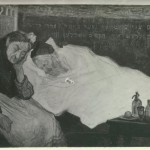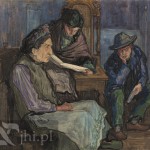Avraham Zvi ben (son of) Shimshon, died on Wednesday (on the week of reading the Parasha) Achari (Mot) Kdoshim. Fifth (of month) Eyiar (year) 5682(1922). Sidlice.By his son Moshe Rynecki.
Frieda Rachel daughter of Ezekiel ARII. Died Saturday (of parashat) Kdoshim, 6 (day of month) Eiar, Year 5684 (1924), Siedlece. And she lived for 82 yearsPainted by her son Moshe Rynecki
The black and white photo on the left is from the Otto Schneid archive at the University of Toronto’s Thomas Fisher Rare Book Library. Although I do not know if this piece survived the Second World War (and if it did, who has it), I know it is in the archive because my great-grandfather mailed the photo to Schneid in 1930. But what I have trouble understanding is why Moshe chose to send a photo of this piece to Schneid as an example of the style and quality of his work. When he mailed this image to Schneid in 1930 he had many other paintings to choose from that were, I would argue, better and more appropriate to share. He was supposed to be presenting a portfolio of his work – to showcase his body of work to Schneid. I’m not convinced this piece does that very well. What about it did he think Schneid would find compelling?
The painting at the right is held by the Jewish Historical Institute (ZIH) in Warsaw. I received a photograph of it a few weeks ago. It was painted two years after the one of his father’s death, but they really are companion pieces and deserve to be hung together. Although I think of the two as a pair, this piece painted for his mother is a very different style than the one done for his father. In the one for his father you can see Avraham on his death bed with a woman, presumably his wife, sitting next to him. But in this painting portraying the death of his mother, what appears to be the same woman from the first painting, is seated along with two other people (who are they?), and his mother is not shown upon her deathbed. Who is this woman who appears in both these paintings? Is it one of Moshe’s sisters? An aunt? A family friend? Perhaps these people are sitting shiva?
[February 2014 update. The original post talked about a third painting held by my family. We have since pulled the “painting” from storage and realize that it is not, in fact, a painting, but a photograph of the painting. It is unclear when, or from whom, my Grandpa George obtained this painting. Here’s what I originally wrote in the blog post, but have now crossed out: The third piece – the one on the far right – is a piece held by my family (my apologies for the rather low quality of the photo). It is, as far as I can ascertain, EXACTLY the same as the piece in the middle held by ZIH. I have seen a few examples of my great-grandfather painting the same scene in a slightly different way, but never a replica of a piece. My father and I are in the midst of trying to resolve this curious discovery. We plan to pull the one we have out of its frame to examine it more closely against the photo of the one held by the Jewish Historical Institute. Perhaps we will be able to more easily discover any possible differences if we do a close analysis. But if the two are exactly the same – the question I most wonder is: Why? The only probable answer I can come up with is that he wanted to give a copy of the painting to someone else who he thought would appreciate having it.]

